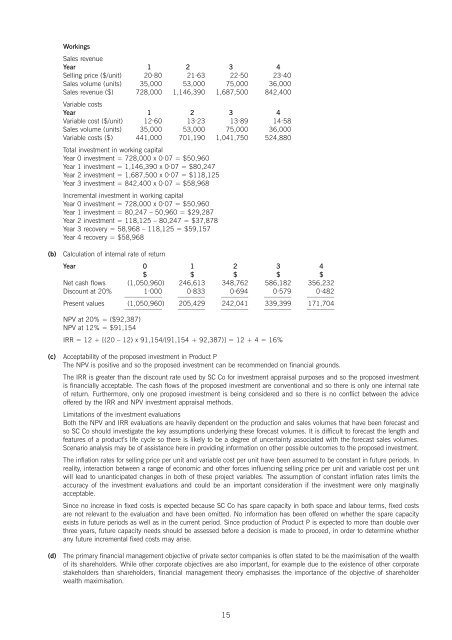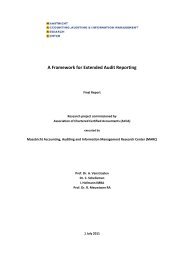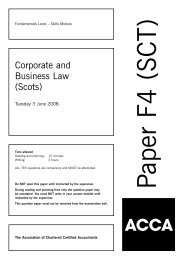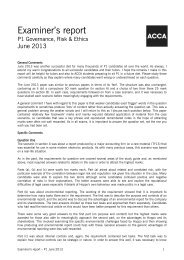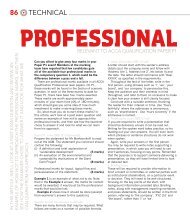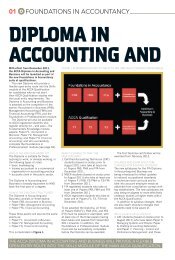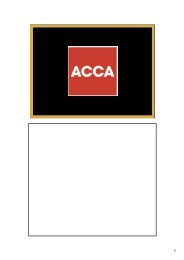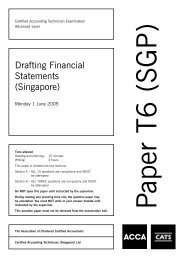Answers - ACCA
Answers - ACCA
Answers - ACCA
You also want an ePaper? Increase the reach of your titles
YUMPU automatically turns print PDFs into web optimized ePapers that Google loves.
Workings<br />
Sales revenue<br />
Year 1 2 3 4<br />
Selling price ($/unit) 20·80 21·63 22·50 23·40<br />
Sales volume (units) 35,000 53,000 75,000 36,000<br />
Sales revenue ($) 728,000 1,146,390 1,687,500 842,400<br />
Variable costs<br />
Year 1 2 3 4<br />
Variable cost ($/unit) 12·60 13·23 13·89 14·58<br />
Sales volume (units) 35,000 53,000 75,000 36,000<br />
Variable costs ($) 441,000 701,190 1,041,750 524,880<br />
Total investment in working capital<br />
Year 0 investment = 728,000 x 0·07 = $50,960<br />
Year 1 investment = 1,146,390 x 0·07 = $80,247<br />
Year 2 investment = 1,687,500 x 0·07 = $118,125<br />
Year 3 investment = 842,400 x 0·07 = $58,968<br />
Incremental investment in working capital<br />
Year 0 investment = 728,000 x 0·07 = $50,960<br />
Year 1 investment = 80,247 – 50,960 = $29,287<br />
Year 2 investment = 118,125 – 80,247 = $37,878<br />
Year 3 recovery = 58,968 – 118,125 = $59,157<br />
Year 4 recovery = $58,968<br />
(b)<br />
(c)<br />
(d)<br />
Calculation of internal rate of return<br />
Year 0 1 2 3 4<br />
$ $ $ $ $<br />
Net cash flows (1,050,960) 246,613 348,762 586,182 356,232<br />
Discount at 20% 1·000<br />
–––––––––––<br />
0·833<br />
––––––––<br />
0·694<br />
––––––––<br />
0·579<br />
––––––––<br />
0·482<br />
––––––––<br />
Present values (1,050,960)<br />
–––––––––––<br />
205,429<br />
––––––––<br />
242,041<br />
––––––––<br />
339,399<br />
––––––––<br />
171,704<br />
––––––––<br />
NPV at 20% = ($92,387)<br />
NPV at 12% = $91,154<br />
IRR = 12 + [(20 – 12) x 91,154/(91,154 + 92,387)] = 12 + 4 = 16%<br />
Acceptability of the proposed investment in Product P<br />
The NPV is positive and so the proposed investment can be recommended on financial grounds.<br />
The IRR is greater than the discount rate used by SC Co for investment appraisal purposes and so the proposed investment<br />
is financially acceptable. The cash flows of the proposed investment are conventional and so there is only one internal rate<br />
of return. Furthermore, only one proposed investment is being considered and so there is no conflict between the advice<br />
offered by the IRR and NPV investment appraisal methods.<br />
Limitations of the investment evaluations<br />
Both the NPV and IRR evaluations are heavily dependent on the production and sales volumes that have been forecast and<br />
so SC Co should investigate the key assumptions underlying these forecast volumes. It is difficult to forecast the length and<br />
features of a product’s life cycle so there is likely to be a degree of uncertainty associated with the forecast sales volumes.<br />
Scenario analysis may be of assistance here in providing information on other possible outcomes to the proposed investment.<br />
The inflation rates for selling price per unit and variable cost per unit have been assumed to be constant in future periods. In<br />
reality, interaction between a range of economic and other forces influencing selling price per unit and variable cost per unit<br />
will lead to unanticipated changes in both of these project variables. The assumption of constant inflation rates limits the<br />
accuracy of the investment evaluations and could be an important consideration if the investment were only marginally<br />
acceptable.<br />
Since no increase in fixed costs is expected because SC Co has spare capacity in both space and labour terms, fixed costs<br />
are not relevant to the evaluation and have been omitted. No information has been offered on whether the spare capacity<br />
exists in future periods as well as in the current period. Since production of Product P is expected to more than double over<br />
three years, future capacity needs should be assessed before a decision is made to proceed, in order to determine whether<br />
any future incremental fixed costs may arise.<br />
The primary financial management objective of private sector companies is often stated to be the maximisation of the wealth<br />
of its shareholders. While other corporate objectives are also important, for example due to the existence of other corporate<br />
stakeholders than shareholders, financial management theory emphasises the importance of the objective of shareholder<br />
wealth maximisation.<br />
15


